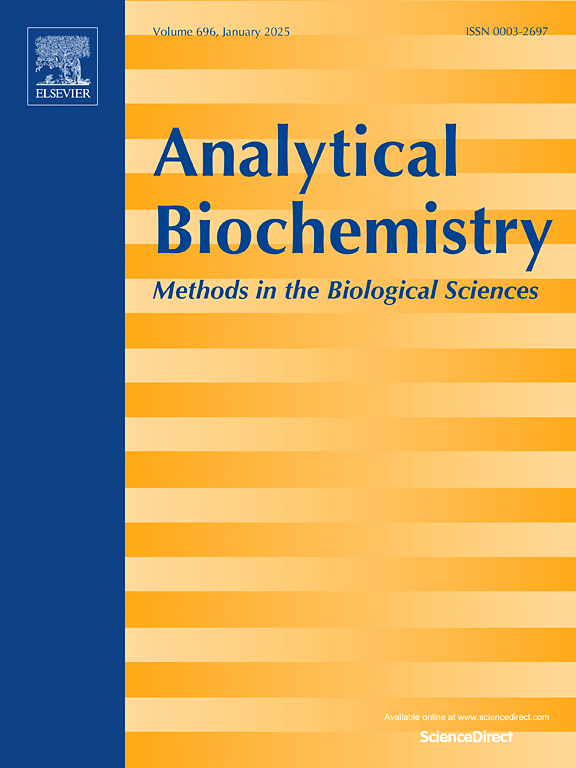Esterase-2 mutant-based nanostructured amperometric biosensors for the selective determination of paraoxon (Neurotoxin)
IF 2.5
4区 生物学
Q2 BIOCHEMICAL RESEARCH METHODS
引用次数: 0
Abstract
Organophosphate pesticides (OPs) are causing non-selective inhibition in enzymatic bioreceptors, thus the enzymatic-inhibition-based traditional assays are not suitable for their specific detection in food and environmental samples. Accordingly, a selective nanostructured electrochemical biosensing system was designed using six mutants of the esterase-2 (EST2 protein) enzymes from A. acidocaldarius to be exploited as targeting bio-receptors for the specific detection of OPs. Each of the EST2 mutant enzymes was immobilized on disposable screen-printed electrodes modified with Aluminum oxide (Al2O3)/Copper (Cu) nanocomposite. Consequently, chronoamperometric assay was fully optimized, and cross-reactivity study was carried out using paraoxon, malathion and chlorpyrifos. The comparative cross-reactivity study was performed on the six mutant proteins in terms of inhibitory percentage over a wide range of pesticide concentrations. Eventually, a wide dynamic inhibition range was achieved while the limit of detection for the paraoxon toxicity was 0.01 nM and the limit of quantification was 0.05 nM. Finally, paraoxon was selectively determined using the newly developed EST-based biosensor in different spiked food samples.

基于酯酶2突变体的纳米结构安培生物传感器选择性测定对氧磷(神经毒素)。
有机磷农药对酶促生物受体具有非选择性抑制作用,因此基于酶抑制的传统检测方法不适合在食品和环境样品中进行特异性检测。基于此,利用酸藻酯酶2 (EST2蛋白)的6个突变体设计了选择性纳米结构电化学生物传感系统,并利用该系统作为靶向生物受体对OPs进行特异性检测。每个EST2突变体酶都固定在用氧化铝(Al2O3)/铜(Cu)纳米复合材料修饰的一次性丝网印刷电极上。因此,对时间电流法进行了充分优化,并对对氧磷、马拉硫磷和毒死蜱进行了交叉反应性研究。比较交叉反应性研究进行了六个突变蛋白的抑制百分比在广泛的农药浓度。最终,在对氧磷毒性检测限为0.01 nM、定量限为0.05 nM的情况下,实现了较宽的动态抑制范围。最后,利用新开发的基于est的生物传感器对不同加标食品样品中的对氧磷进行选择性测定。
本文章由计算机程序翻译,如有差异,请以英文原文为准。
求助全文
约1分钟内获得全文
求助全文
来源期刊

Analytical biochemistry
生物-分析化学
CiteScore
5.70
自引率
0.00%
发文量
283
审稿时长
44 days
期刊介绍:
The journal''s title Analytical Biochemistry: Methods in the Biological Sciences declares its broad scope: methods for the basic biological sciences that include biochemistry, molecular genetics, cell biology, proteomics, immunology, bioinformatics and wherever the frontiers of research take the field.
The emphasis is on methods from the strictly analytical to the more preparative that would include novel approaches to protein purification as well as improvements in cell and organ culture. The actual techniques are equally inclusive ranging from aptamers to zymology.
The journal has been particularly active in:
-Analytical techniques for biological molecules-
Aptamer selection and utilization-
Biosensors-
Chromatography-
Cloning, sequencing and mutagenesis-
Electrochemical methods-
Electrophoresis-
Enzyme characterization methods-
Immunological approaches-
Mass spectrometry of proteins and nucleic acids-
Metabolomics-
Nano level techniques-
Optical spectroscopy in all its forms.
The journal is reluctant to include most drug and strictly clinical studies as there are more suitable publication platforms for these types of papers.
 求助内容:
求助内容: 应助结果提醒方式:
应助结果提醒方式:


